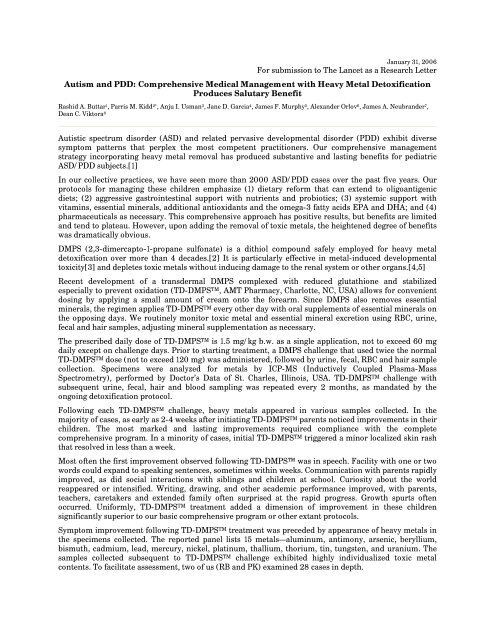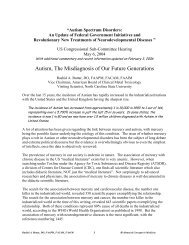For submission to The Lancet as a Research Letter Autism and PDD ...
For submission to The Lancet as a Research Letter Autism and PDD ...
For submission to The Lancet as a Research Letter Autism and PDD ...
Create successful ePaper yourself
Turn your PDF publications into a flip-book with our unique Google optimized e-Paper software.
January 31, 2006<br />
<strong>For</strong> <strong>submission</strong> <strong>to</strong> <strong>The</strong> <strong>Lancet</strong> <strong>as</strong> a <strong>Research</strong> <strong>Letter</strong><br />
<strong>Autism</strong> <strong>and</strong> <strong>PDD</strong>: Comprehensive Medical Management with Heavy Metal De<strong>to</strong>xification<br />
Produces Salutary Benefit<br />
R<strong>as</strong>hid A. Buttar 1 , Parris M. Kidd 2* , Anju I. Usman 3 , Jane D. Garcia 4 , James F. Murphy 5 , Alex<strong>and</strong>er Orlov 6 , James A. Neubr<strong>and</strong>er 7 ,<br />
Dean C. Vik<strong>to</strong>ra 8<br />
Autistic spectrum disorder (ASD) <strong>and</strong> related perv<strong>as</strong>ive developmental disorder (<strong>PDD</strong>) exhibit diverse<br />
symp<strong>to</strong>m patterns that perplex the most competent practitioners. Our comprehensive management<br />
strategy incorporating heavy metal removal h<strong>as</strong> produced substantive <strong>and</strong> l<strong>as</strong>ting benefits for pediatric<br />
ASD/<strong>PDD</strong> subjects.[1]<br />
In our collective practices, we have seen more than 2000 ASD/<strong>PDD</strong> c<strong>as</strong>es over the p<strong>as</strong>t five years. Our<br />
pro<strong>to</strong>cols for managing these children emph<strong>as</strong>ize (1) dietary reform that can extend <strong>to</strong> oligoantigenic<br />
diets; (2) aggressive g<strong>as</strong>trointestinal support with nutrients <strong>and</strong> probiotics; (3) systemic support with<br />
vitamins, essential minerals, additional antioxidants <strong>and</strong> the omega-3 fatty acids EPA <strong>and</strong> DHA; <strong>and</strong> (4)<br />
pharmaceuticals <strong>as</strong> necessary. This comprehensive approach h<strong>as</strong> positive results, but benefits are limited<br />
<strong>and</strong> tend <strong>to</strong> plateau. However, upon adding the removal of <strong>to</strong>xic metals, the heightened degree of benefits<br />
w<strong>as</strong> dramatically obvious.<br />
DMPS (2,3-dimercap<strong>to</strong>-1-propane sulfonate) is a dithiol compound safely employed for heavy metal<br />
de<strong>to</strong>xification over more than 4 decades.[2] It is particularly effective in metal-induced developmental<br />
<strong>to</strong>xicity[3] <strong>and</strong> depletes <strong>to</strong>xic metals without inducing damage <strong>to</strong> the renal system or other organs.[4,5]<br />
Recent development of a transdermal DMPS complexed with reduced glutathione <strong>and</strong> stabilized<br />
especially <strong>to</strong> prevent oxidation (TD-DMPS TM , AMT Pharmacy, Charlotte, NC, USA) allows for convenient<br />
dosing by applying a small amount of cream on<strong>to</strong> the forearm. Since DMPS also removes essential<br />
minerals, the regimen applies TD-DMPS TM every other day with oral supplements of essential minerals on<br />
the opposing days. We routinely moni<strong>to</strong>r <strong>to</strong>xic metal <strong>and</strong> essential mineral excretion using RBC, urine,<br />
fecal <strong>and</strong> hair samples, adjusting mineral supplementation <strong>as</strong> necessary.<br />
<strong>The</strong> prescribed daily dose of TD-DMPS TM is 1.5 mg/kg b.w. <strong>as</strong> a single application, not <strong>to</strong> exceed 60 mg<br />
daily except on challenge days. Prior <strong>to</strong> starting treatment, a DMPS challenge that used twice the normal<br />
TD-DMPS TM dose (not <strong>to</strong> exceed 120 mg) w<strong>as</strong> administered, followed by urine, fecal, RBC <strong>and</strong> hair sample<br />
collection. Specimens were analyzed for metals by ICP-MS (Inductively Coupled Pl<strong>as</strong>ma-M<strong>as</strong>s<br />
Spectrometry), performed by Doc<strong>to</strong>r’s Data of St. Charles, Illinois, USA. TD-DMPS TM challenge with<br />
subsequent urine, fecal, hair <strong>and</strong> blood sampling w<strong>as</strong> repeated every 2 months, <strong>as</strong> m<strong>and</strong>ated by the<br />
ongoing de<strong>to</strong>xification pro<strong>to</strong>col.<br />
Following each TD-DMPS TM challenge, heavy metals appeared in various samples collected. In the<br />
majority of c<strong>as</strong>es, <strong>as</strong> early <strong>as</strong> 2-4 weeks after initiating TD-DMPS TM parents noticed improvements in their<br />
children. <strong>The</strong> most marked <strong>and</strong> l<strong>as</strong>ting improvements required compliance with the complete<br />
comprehensive program. In a minority of c<strong>as</strong>es, initial TD-DMPS TM triggered a minor localized skin r<strong>as</strong>h<br />
that resolved in less than a week.<br />
Most often the first improvement observed following TD-DMPS w<strong>as</strong> in speech. Facility with one or two<br />
words could exp<strong>and</strong> <strong>to</strong> speaking sentences, sometimes within weeks. Communication with parents rapidly<br />
improved, <strong>as</strong> did social interactions with siblings <strong>and</strong> children at school. Curiosity about the world<br />
reappeared or intensified. Writing, drawing, <strong>and</strong> other academic performance improved, with parents,<br />
teachers, caretakers <strong>and</strong> extended family often surprised at the rapid progress. Growth spurts often<br />
occurred. Uniformly, TD-DMPS TM treatment added a dimension of improvement in these children<br />
significantly superior <strong>to</strong> our b<strong>as</strong>ic comprehensive program or other extant pro<strong>to</strong>cols.<br />
Symp<strong>to</strong>m improvement following TD-DMPS TM treatment w<strong>as</strong> preceded by appearance of heavy metals in<br />
the specimens collected. <strong>The</strong> reported panel lists 15 metals—aluminum, antimony, arsenic, beryllium,<br />
bismuth, cadmium, lead, mercury, nickel, platinum, thallium, thorium, tin, tungsten, <strong>and</strong> uranium. <strong>The</strong><br />
samples collected subsequent <strong>to</strong> TD-DMPS TM challenge exhibited highly individualized <strong>to</strong>xic metal<br />
contents. To facilitate <strong>as</strong>sessment, two of us (RB <strong>and</strong> PK) examined 28 c<strong>as</strong>es in depth.
All said patients had independent, 3 rd party ASD or <strong>PDD</strong> diagnoses from qualified practitioners, with ages<br />
ranging from 2-11 years upon admission. On average, their first TD-DMPS TM challenge excreted more<br />
than 7 different <strong>to</strong>xic metals (range 2-12). Arsenic w<strong>as</strong> most often seen (100%) on first challenge.<br />
Cadmium, nickel <strong>and</strong> tin were next (86%). Subsequent challenges resulted in some metals declining while<br />
others waxed <strong>and</strong> waned in quantity.<br />
Mercury appeared at initial urine challenge in 16 of 28 c<strong>as</strong>es (57%), but in subsequent challenges, became<br />
evident in all except one (96%). <strong>The</strong> exception, a 5-year-old female, showed no detectable urinary mercury<br />
after 4 challenges but did show marked clinical improvements while manifesting high, aluminum,<br />
cadmium <strong>and</strong> nickel. However, further review revealed incre<strong>as</strong>ing mercury levels in fecal <strong>and</strong> hair<br />
samples during the same time period.<br />
Our clinical experience with ASD/PPD led us <strong>to</strong> suspect mercury <strong>as</strong> the main <strong>to</strong>xic culprit. This metal is<br />
no<strong>to</strong>riously neuro<strong>to</strong>xic <strong>and</strong> tera<strong>to</strong>genic.[3] But the urinary excretion patterns suggest mercury may not be<br />
the sole <strong>to</strong>xic challenge for this population. <strong>The</strong>se children may have an impaired de<strong>to</strong>xification capacity<br />
for a variety of <strong>to</strong>xic metals, <strong>and</strong> this along with the synergistic destructive nature of these heavy metals<br />
may be a pivotal etiologic fac<strong>to</strong>r in this population.<br />
In summary, our collective clinical experience with ASD/<strong>PDD</strong> children suggests a comprehensive<br />
approach <strong>to</strong> their management is very useful. However, ameliorating their body burden of arsenic,<br />
cadmium, nickel, mercury, tin, thallium, tungsten, lead, antimony, <strong>and</strong> other <strong>to</strong>xic metals markedly<br />
exp<strong>and</strong>s their dimension of benefit <strong>and</strong> is essential <strong>to</strong> the most optimistic outcome. <strong>The</strong> diverse benefits of<br />
<strong>to</strong>xic metal depletion are well established.[4,5] Feedback from parents augments our clinical observations<br />
that ASD/PPD children are able <strong>to</strong> thrive <strong>and</strong> substantially resume normal development, once this barrier<br />
of <strong>to</strong>xic metal burden is removed.<br />
References<br />
1. Buttar RA. <strong>Autism</strong>, the misdiagnosis of our future generations. In, <strong>Autism</strong> Spectrum Disorders: An Update of Federal Government<br />
Initiatives <strong>and</strong> Revolutionary New Treatments of Neurodevelopmental Dise<strong>as</strong>es. Transcript of the U.S. Congressional Sub-<br />
Committee Hearing on Human Rights <strong>and</strong> Wellness, 2004 (May 6); (939 pages).<br />
2. Aposhian HV. Mobilization of heavy metals by newer, therapeutically useful chelating agents. Toxicology 1995;97:23-38.<br />
3. Domingo JL. Prevention by chelating agents of metal-induced developmental <strong>to</strong>xicity. Reprod. Toxicol. 1995;9:105-13.<br />
4. Guha Mazumder DN, et al. R<strong>and</strong>omized placebo-controlled trial of 2,3-dimercap<strong>to</strong>-1-propanesulfonate (DMPS) in therapy of<br />
chronic arsenicosis due <strong>to</strong> drinking arsenic-contaminated water. J. Toxicol. Clin. Toxicol. 2001;39:665-74.<br />
5. Bose-O'Reilly S, et al. <strong>The</strong> Mt. Diwata study on the Philippines 2000-treatment of mercury in<strong>to</strong>xicated inhabitants of a gold<br />
mining area with DMPS. Sci. Total Environ. 2003;307:71-82.<br />
Footnote-authors’ qualifications <strong>and</strong> affiliations<br />
1. R<strong>as</strong>hid A. Buttar, DO, Visiting Scientist, North Carolina State University, <strong>and</strong> Medical Direc<strong>to</strong>r, Center for Advanced Medicine,<br />
Cornelius, NC, USA<br />
2. Parris M. Kidd, PhD, PMK Biomedical Consulting, El Cerri<strong>to</strong>, CA, USA*.<br />
3. Anju I. Usman, MD, True Health Medical Center, Naperville, IL, USA<br />
4. Jane D. Garcia, ANP, Center for Advanced Medicine, Cornelius, NC, USA<br />
5. James F. Murphy, DO, Corners<strong>to</strong>ne Progressive Health, Omaha, NE, USA<br />
6. Alex<strong>and</strong>er Orlov, DO, ACOFP, Austin Wellness Institute, Austin, TX, USA<br />
7. James A. Neubr<strong>and</strong>er, MD, FAAEM, private practice, Edison, NJ, USA<br />
8. Dean C. Vik<strong>to</strong>ra, PhD, Labora<strong>to</strong>ry Direc<strong>to</strong>r, V-SAB Medical Labora<strong>to</strong>ries, Inc. <strong>and</strong> <strong>Research</strong>er, Center for Advanced Medicine,<br />
Cornelius, NC, USA<br />
* = Author for correspondence<br />
Conflict of Interest Statement<br />
Dr. Parris Kidd w<strong>as</strong> compensated by Dr. R<strong>as</strong>hid Buttar <strong>to</strong> oversee the manuscript preparation process <strong>and</strong> shepherd it through<br />
publication. <strong>The</strong> other authors were self-funded <strong>and</strong> received no outside support for their contributions <strong>to</strong> this report.




